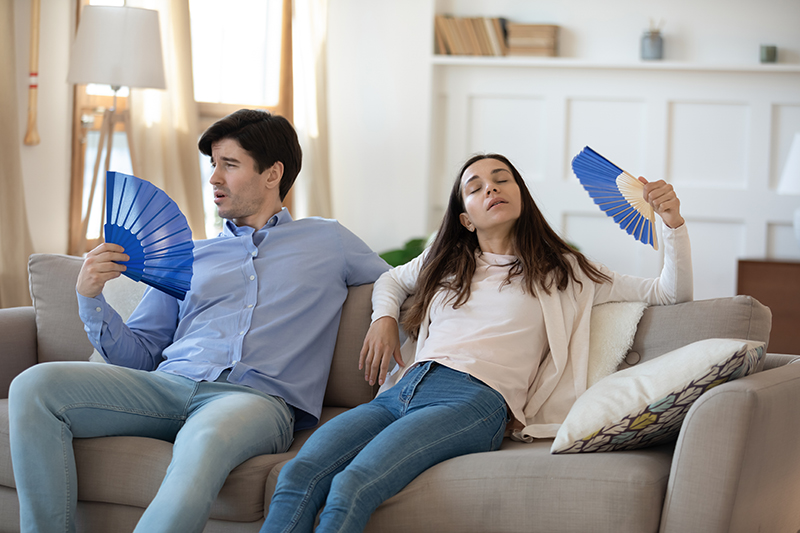It’s frustrating when your home feels humid even with the air conditioning on. Instead of enjoying a cool and comfortable atmosphere, you’re stuck in a moisture-laden environment that makes the summer heat even harder to bear. If you’re dealing with this sticky issue, you’re seeking answers and relief.
Humidity has a knack for sneaking into places where it’s least welcome, and sometimes an AC unit can’t keep up. Whether it’s due to technical issues, a mismatch between your AC’s capacity and your home’s size, or external factors contributing to the indoor dampness, understanding the root cause is key to finding a solution.
This post is your guide to uncovering why your air conditioner isn’t cutting the humidity and what you can do to fix it. Let’s clear the air and turn your home back into the cool haven it should be.
Quick Answer to High Humidity with AC On
If your home is feeling more like a sauna than a sanctuary, even with the air conditioner running, there are several potential reasons behind the excessive moisture:
- Oversized AC Units: A unit that’s too big for your space can cool the air quickly but without running long enough to remove humidity effectively.
- Poor Maintenance: An AC system that hasn’t been serviced may struggle with humidity due to dirty coils or a failing compressor.
- Outdoor Humidity Infiltration: Moisture can enter your home through various channels, including poor sealing around doors and windows.
- Inadequate Ventilation: Homes that don’t allow for proper air exchange can trap humid air inside.
- Leaky Ductwork: Ducts with leaks can draw air from humid parts of the house or the outside, increasing the moisture level.
- Continuous Fan Setting: Using the AC fan continuously can disrupt the removal of moisture by blowing humid air back into the home before it can be drained away.
- Internal Sources of Humidity: Daily activities, such as cooking, bathing, and drying clothes, can add to the humidity level inside your house.
In the upcoming sections, we’ll dive deeper into each of these factors. We’ll provide you with insights on how to spot these issues and practical tips on how to resolve them, restoring the balance and comfort of your indoor climate. Stick with us as we unpack the solutions that will help you maintain a perfectly balanced, moisture-free home.
Causes and Solutions for High Humidity
Oversized AC Units
Problem Explained: Inefficient Dehumidification
An air conditioner that’s too large for a room will cool the space quickly, but it won’t operate long enough to reduce humidity. This inefficiency arises because the unit meets the thermostat’s temperature setting before it has a chance to remove sufficient moisture from the air, leading to uncomfortable humidity levels.
Identifying an Oversized AC
To check if your AC unit is oversized, monitor the cooling pattern: does it turn off too quickly after starting up? Excessively short cycles can indicate an oversized unit. A disproportionate cooling to humidity removal ratio—where your home reaches the desired temperature but remains humid—also suggests the AC unit is too large for your space.
Solutions for Oversized AC Units
The definitive solution is to have an HVAC professional evaluate and potentially replace the oversized unit with one that’s correctly sized for your home. In the meantime, employing dehumidifiers or adjusting your thermostat to a mode that allows the fan to run intermittently with the cooling cycles can help manage humidity. These steps are practical ways to enhance comfort until you can address the core sizing issue.
Poor Maintenance
Problem Explained: Maintenance and Humidity Control
Air conditioners require regular maintenance to function efficiently. Neglected maintenance can lead to a buildup of dirt and dust in the coils and filters, which impedes the unit’s ability to cool and dehumidify the air. A well-maintained AC system is crucial for effective humidity and temperature control within your home.
Identifying Maintenance Issues
Signs of a maintenance-related issue include reduced airflow, the presence of frost on the evaporator coils, and strange noises during operation. If the AC seems to run as usual but your house remains humid, or if you haven’t had regular AC servicing in over a year, it’s time for a maintenance checkup.
Solutions for Maintenance Neglect
Regularly scheduled professional maintenance is the best way to ensure your AC operates at peak efficiency. This includes cleaning or replacing air filters, inspecting and cleaning the evaporator and condenser coils, checking the refrigerant level, and ensuring the system’s blower is functioning correctly. Homeowners can also maintain their units by regularly changing filters and keeping the area around outdoor units clear of debris. These measures can significantly improve the AC’s dehumidification capacity.
Outdoor Humidity Infiltration
Problem Explained: When Outside Humidity Comes In
Even with the AC on, outdoor air can infiltrate your home, bringing with it the humidity that your AC then has to remove. If there are leaks, poor insulation, or inadequate seals on doors and windows, this outdoor air can significantly increase indoor humidity levels.
Identifying Infiltration as the Culprit
To determine if outdoor humidity is seeping into your home, check for drafts around windows and doors, dampness on walls or windows, and fluctuating indoor humidity levels that correspond with outdoor conditions. An increase in indoor humidity following periods of outdoor warmth and moisture often points to infiltration issues.
Solutions for Stopping Humidity at the Door
The most effective strategy to keep outside humidity out is to improve your home’s sealing and insulation. This might include installing weather stripping, applying caulking around windows and doors, and ensuring that insulation is adequate and in good condition. In addition to structural fixes, using window treatments or films can also help by providing an additional barrier to humidity. Regular checks for gaps, cracks, and other openings in your home’s exterior will go a long way in keeping your indoor air dry and cool.
Inadequate Ventilation
Problem Explained: Lack of Airflow Enhances Humidity
Proper ventilation is essential for controlling indoor humidity. Inadequate ventilation means the moisture produced inside your home by everyday activities has nowhere to go, leading to increased humidity levels. This can be especially problematic in homes with tight construction that are designed to be energy-efficient but may lack sufficient airflow.
Identifying Poor Ventilation
You can spot signs of inadequate ventilation if your home feels stuffy, odors linger longer than usual, or there’s an excess of condensation on windows and mirrors. Persistent humidity in certain areas, like the kitchen or bathroom, which remain after the AC cycles off, also indicates poor air exchange.
Solutions for Improving Ventilation
Improving your home’s ventilation may require a multi-faceted approach. This could include installing exhaust fans in high moisture areas like bathrooms and kitchens, ensuring attic vents are unblocked, and possibly integrating a heat recovery ventilator (HRV) system to enhance airflow without losing the cooling effect of your AC. Regular use of fans to circulate air can also promote better ventilation, helping to carry away moist air and bring in drier air from other parts of the home or outside if the outdoor air is dry.
Leaky Ductwork
Problem Explained: The Ductwork Dilemma
Leaky ductwork can introduce extra moisture into your home by pulling in humid air from outside or from unconditioned spaces within your home. This issue is particularly troublesome because it not only increases humidity but also reduces the overall efficiency of your air conditioning system.
Identifying Ductwork Leaks
Look for telltale signs of duct leaks, such as visible holes or tears in exposed ductwork, dusty rooms after the AC has run (indicating air is being pulled from attics or crawl spaces), or inconsistent air delivery and temperature in different rooms. An HVAC professional can conduct a pressure test to provide a definitive diagnosis.
Solutions for Leaky Ductwork
Sealing leaky ducts is crucial to prevent humid air from seeping into your home. Duct sealing can range from simple DIY fixes with mastic sealant or metal tape to professional sealing and insulation. It’s also beneficial to have your entire duct system inspected and cleaned by professionals to ensure it is airtight and free from efficiency-reducing buildup. In some cases, replacing old, inefficient ductwork might be the best long-term solution to maintain a comfortable and humidity-controlled home environment.
Continuous Fan Setting
Problem Explained: Continuous Fan and Humidity Woes
Using your AC’s fan setting on ‘continuous’ can lead to higher humidity levels indoors. The constant airflow can prevent moisture from condensing on the coils and being drained away, cycling the humidity back into your home instead of removing it.
Identifying Fan-Related Humidity Issues
If you notice that humidity problems persist despite running the AC, check the fan setting on your thermostat. It should be set to ‘auto’ rather than ‘on,’ ensuring that the fan operates only during cooling cycles. If the fan is running continuously, it’s likely contributing to your home’s moisture issues.
Solutions for Fan Setting Adjustments
Changing the fan setting from ‘on’ to ‘auto’ on your thermostat is a simple yet effective solution. This ensures the fan only blows when the AC system cools, allowing the indoor coil to remove moisture effectively as air passes over it. For additional humidity control, consider installing a thermostat with a built-in humidity sensor that adjusts the cooling and fan operation to optimize indoor humidity levels. Regular maintenance of the AC system, ensuring the fan and its components are in good working order, can also help maintain desired humidity levels.
Internal Sources of Humidity
Problem Explained: Home Activities Elevating Moisture Levels
Everyday activities like cooking, bathing, and drying clothes can significantly contribute to the humidity levels in your home. Without proper ventilation and moisture control, these internal sources can make your air feel more humid, even with the AC running.
Identifying High Indoor Humidity from Daily Activities
You might observe that humidity levels spike after a shower, cooking, or running the dryer. If these humidity levels don’t subside or if you notice condensation forming on windows or cold surfaces following these activities, it’s likely that they are contributing to your home’s overall humidity.
Solutions for Home-Generated Humidity
Improving ventilation is key to managing moisture from daily activities. Use exhaust fans in bathrooms and kitchens, and vent clothes dryers to the outside. Additionally, consider air-drying clothes outdoors when possible, using lids on pots while cooking to contain steam, and taking cooler, shorter showers. For a more sophisticated approach, you might install a dehumidifier, either portable or whole-home, to actively remove excess moisture from the air. Ensuring that your AC unit is correctly sized and well-maintained will also help in effectively managing the humidity generated inside your home.
Keep Your Cool with Steve’s Plumbing & AC
In conclusion, maintaining the perfect balance of cool and dry air in your home during the hotter months isn’t just about running your AC; it’s about ensuring that the entire system is working in harmony. From choosing the right-sized AC unit and keeping up with regular maintenance to improving ventilation and managing internal humidity sources, there’s a lot you can do to reduce the moisture in your home’s air.
However, sometimes you need a helping hand to tackle the high humidity. That’s where Steve’s Plumbing & AC comes into play. With a reputation for providing top-notch AC repair, maintenance, and installation services in Hawaii, Steve’s is your go-to expert for creating a comfortable and humidity-free environment in your home. Whether you’re facing AC oversizing issues, ventilation challenges, or ductwork dilemmas, the skilled technicians at Steve’s have the know-how to fix it fast and fix it right.
Don’t let high humidity dampen your comfort. Call Steve’s Plumbing & AC today at (808) 563-4054 and take the first step towards a fresher, drier, and cooler home. With Steve’s, you’re in good hands, rain or shine.


